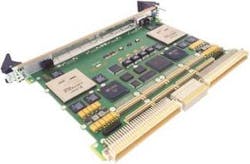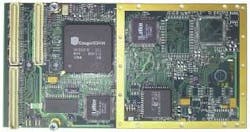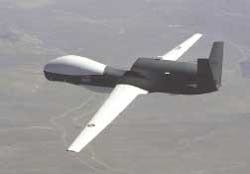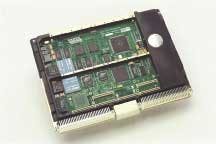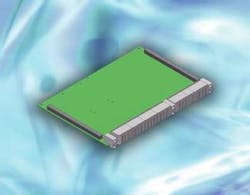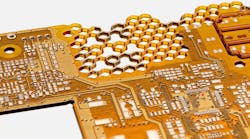By Ben Ames
VME holds on for another decade as single-board computers grow faster, yet how long VME remains on the scene depends on the growing popularity of 3U CompactPCI and the next generations of fast-switched fabrics.
Military electronics designers overwhelmingly choose the VME printed-circuit-card form factor and databus for their single-board computers; that is not going to change anytime soon. Yet they are using some new commercial technologies, such as faster processors and shrinking components. Eventually, that will force military designers to adopt faster standards like CompactPCI and then to drop databuses altogether, moving to switched fabrics.
The movement has begun, though military engineers are famously reluctant to change.
"This industry has a big fly-wheel; it's slow to adopt technologies, but then it keeps them a long time," says Joe Pavlat, president of the PCI Industrial Computing Manufacturers Group (PICMG), in Wakefield, Mass.
Despite that inertia, we're in an era of change. More and more designers are using Compact PCI instead of VME for new devices in military and aerospace. And even that may not last.
"The days of running your host microprocessor across the backplane are almost over, because it can't go fast enough," he says. "So people are going to switched serial interconnects [known as fabrics], instead of a parallel databus like VME or CompactPCI."
Another trend pushing the adoption of switched fabrics is Pentagon leaders' concept of network-centric warfare, which demands very high bandwidth to achieve its goal of getting any data to any soldier at any time.
Alternative technologies like optical interconnects and optical backplanes are not ready yet. "Five years ago, I said they were five years away, and they still are," Pavlat says. So that leaves switched fabrics as the only option.
Switched fabrics are also pushed by the spread of networks and blade computing. In that architecture, cards communicate not by databus, but by high-speed network. That network is usually Ethernet, an entrenched technology that's boosting its bandwidth quickly from the current 10/100 to Gigabit Ethernet, and soon to 10-Gigabit Ethernet, he says.
In addition to speed, interconnects like Ethernet, Infiniband, Rapid I/O, and PCI Express are more robust than a parallel databus. An onboard systems-management controller can automatically switch traffic from a failed component to its redundant backup. That controller could reside on a separate serial bus, piggyback on the main bus, or interconnect from its own card, he says.
Engineers have used systems-management controllers for years in proprietary designs, particularly for redundant avionics, yet this technology is emerging today as an open standard. It is part of ATCA, which is used primarily in telecommunications, and is part of the PICMG 2.16 standard, which specifies switched Ethernet instead of a parallel databus.
Compared to proprietary designs, open standards spark competition over cost and features, Pavlat says. That is particularly true because many customers can no longer assemble their own boards in-house; they laid off too many engineers in the last recession.
At the same time, those customers are demanding more features for their new designs. "People want more bandwidth, availability, open architecture, and system management," Pavlat says. "You can never be too rich, too thin, or have too much bandwidth."
Military designers are also specifying smaller components, using the 3U instead of 6U form factor, and are running the smaller computers with powerful field programmable gate arrays (FPGAs), which could not have handled the job 10 years ago, he says.
VME's hold on the military
The VME standard in single-board computers will hold onto its market share in military and aerospace applications, but will quickly lose way to CompactPCI in the market as a whole, says Eric Gulliksen, at analyst at market researcher Venture Development Corp. in Natick, Mass.
The military and aerospace sector accounted for 16.5 percent of the overall market in 2002, finishing third behind telecommunications and industrial control/automation. The military sector will likely shrink in 2003 and 2004 as other industries speed their recoveries from the recession.
"You're not going to design something unless you think you can sell it. But mil-aero has such a long cycle," Pavlat says. "In communications, you rush a product out there faster and it goes away faster. But especially in combat, they won't put something out there that's not tried and true; they're not cutting edge, and don't need to be."
The VME bus represented 39 percent of the dollar value of all single-board computer shipments in 2003. That will drop to 29 percent by 2007, Gulliksen predicts. CompactPCI will make up the difference, rising from 26 to 31 percent. Other standards represent smaller shares. Meanwhile, the overall market will not change much in that period, rising merely from $1.03 billion to $1.09 billion by 2007.
In terms of interconnects, most single-board computers sold on the general market in 2002 did not use switch fabrics, he says. Just 28.5 percent used Ethernet fabric, and 2.5 percent used Star fabric. Those numbers were higher in the military and aerospace sector.
VME will continue to grow slowly, agrees Jerry Krasner, founder and principal analyst at Embedded Forecast Forecasters in Framingham, Mass.
The military commercial off-the-shelf (COTS) market in general will grow, as Pentagon planners replace equipment used in Iraq and Afghanistan. At the same time, Defense Secretary Donald Rumsfeld continues to enact his vision of achieving victory through more technology and less manpower.
More specifically, VME has great momentum from its large installed base. By comparison, CompactPCI does not have the real time or multiprocessing capabilities needed for widespread military use, he says. So designers will use that technology primarily for applications in telecommunications, not industrial automation or military.
Furthermore, the VME standard thrives on strong competition, because 22 companies share 75 percent of the market. By comparison, just four companies split the Compact PCI market, making it a slow-developing commodity, he says.
Finally, other form factors like PC104 are quickly being replaced by FPGAs. And other choices like ATCA have just small slices of the market.
VITA standards speed VME
Military users will keep using VME for another decade, says Jeffrey Harris, director of system engineering for VME products at the Motorola Computer Group, in Tempe, Ariz.
VME technology has thrived for 20 years because it evolves to faster bus speeds, and still maintains backward compatibility to relatively old designs. It also supports do-it-yourself integration; many Motorola customers choose to build their own boards in-house to satisfy unique needs or to ensure secrecy.
"The next wave of VME will be good for another decade," Harris says. To do that, the standard will have to work around a growing bottleneck. Boards can handle more computing as they use today's powerful processors, but they cannot communicate any faster with other boards.
There are some intermediate solutions. Researchers at the VMEbus International Trade Association (VITA) in Scottsdale, Ariz., have created hybrid standards that combine the speed of serial fabrics with the familiarity of bus architectures.
The VITA 41 standard (VXS) would specify a dual-star configuration on the VME backplane in addition to its bus. That would boost speed from 10 Gigabits per second to 40 while still preserving the bus structure, Harris says.
The VITA 42 standard (XMC) would forge a similar system on the board itself, by bringing point-to-point connections to mezzanine cards, such as the CMC, common mezzanine card, or PMC, PCI Mezzanine card.
Both solutions would be temporary patches. More complex designs will eventually force too many connections onto each card and signal integrity will suffer, he says. Over time, the design paradigm must change from bus interconnects to switched-serial interconnects.
The first military applications to hit this limit will be those that move bulk data or demand low latency, such as radar, sonar, digital signal processing, or image processing.
Even those will take time to change, since the military market is slow to adopt and drop technologies, he says. Its design-in cycle for new electronics is three to five years, compared to 18 to 24 months for other industries; entrenched technologies linger for decades.
VITA 46 (VPX) is a response to military equipment designers who demand relatively large numbers of pins on the backplane.
That would add more speed and bandwidth, but planners cannot agree how much. One camp says the standard should add two rows of pins — totaling seven — so the older standards of five and three rows would still fit inside. The other camp says the standard should use a brand new connector, which could boost speed even higher.
Motorola planners support the first group, but predict that both will survive, and the market will eventually decide a winner, Harris says.
Ethernet pushes VME
Boards have always been able to handle data flow on their existing connectors because most I/O has been in the subgigahertz range. But that will end as soon as designers move from 10/100 Ethernet to Gigabit Ethernet and then to 10-Gigabit Ethernet, says Richard Jaenicke, director of product marketing at Mercury Computer Systems in Chelmsford, Mass.
Many designers want to cut bait on the old connector standards, yet continue running the VME protocol. VME has always proliferated because it is flexible enough to accommodate relatively old boards without using bridges.
Now the new VITA standards could challenge those design assumptions, as engineers seek ways to fit switched serial on a VME board, Jaenicke says.
Designers will find out soon. XMC boards could hit the market in the second half of 2004, and VPX boards could be produced by early 2005, he says.
Under the new standards, board designers will be able to run I/O on the mezzanine card again. They had to abandon that design in the past, running I/O on the mother board or VME. The return would be an especially big boon for processor-based mezzanine cards because boards are most efficient when they keep the I/O and processors as close as possible.
In preparation, Mercury planners have started fielding systems with Rapid I/O, and have switched mezzanine cards over to XMC to support PMC or XMC with Rapid I/O.
"At the system level, we think more people will want PMC more than VME or Compact PCI boards, because it's easier to design the boards," Jaenicke says. Users with customized I/O needs will choose XMC, which can handle any speed. Either way, engineers at Mercury would design the systems because many customers laid off their own board engineers in the recent recession.
Evolving single-board computers
These upgrades will change the very definition of the single-board computer's role in military electronics.
As their speed and performance improve, single-board computers progress beyond their traditional function of managing a clock for the other boards in a bus. They can also do signal processing and data storage, says Rodger Hosking, vice president at Pentek, Upper Saddle River, N.J.
Mezzanine cards can make the single-board computer a jack-of-all-trades, he says. With a Gigabit Ethernet card, a single-board computer can manage the Fibre Channel port to a hard drive, and with a 1553 interface it can manage the military aircraft bus for consoles, munitions, and instruments.
Processors are still increasing in power. Single-board computers today can run a 1-GHz G4 PowerPC, and that kind of horsepower lets the single-board computer move far beyond the task of managing a bus or RS232 port, to handle heavy signal processing.
Some designers are building single-board computers with increasing amounts of memory on board, allowing the board to better buffer its data, and send data streams at different rates. Pentek makes a board today with a gigabyte of SDRAM solid-state memory.
Pentek designers push this change even further. While standard single-board computers have one or two processors on board, most of Pentek's offerings have four or eight processors, allowing them to perform heavy-duty digital signal processing. Their model 4205 is an example.
Boards for graphics
Single-board computers with powerful processors and high-speed data connections can do much more than manage a bus. Because they can now handle heavy data, military customers increasingly use them to drive graphics and displays.
To save space, many designers use dual-head graphics cards to run several displays from one slot. In fact, some boards are already so powerful they can run graphics data on bridge chips, says Victor Gold, vice president of graphics engineering at Peritek in Oakland, Calif. "It's only a matter of time until you see the separate graphics accelerator as a thing of the past," he says.
In another trend, many users are moving toward PCI-X (PCI Extended). Peritek will release the industry's first PCI-X-compatible PCM card in early 2004.
Likewise, designers from Vista Controls in Santa Clarita, Calif., have a PCI-X board in process. Its next-generation PowerPC 6U CompactPCI card was due in January. Curtiss-Wright Corp. in Roseland, N.J., owns Vista and Peritek.
Customers will value the higher bandwidth, because the entire computer system is on one card now, says Doug Patterson, director of marketing at Vista. Parallel buses have grown so fast that data's "time of flight" through the card could now cause bottlenecks. Pending serial fabric designs will also address this challenge.
In the meantime, VME and 1553 are still going strong. Several companies are extending the life of 1553 by running wavelength-division multiplexing (WDM) over it, Patterson says.
That could work, but change takes time. Designers can use fast fiber on new platforms, but they must cope with the existing cabling for upgrades, and learn to superimpose new standards like Gigabit Ethernet over the old wires.
Companies are left straddling the design paradigms. For the Global Hawk unmanned aerial vehicle (UAV), Vista has supplied a VME-based improved mission-management computer and digital signal processing for the synthetic aperture radar. For the Army's Future Combat System, Vista engineers will build a double Gigabit Ethernet to move data for radar processing, automatic ammunition handling, and mass memory, Patterson says.
Board features
Military designers use mainly VMEbus, increasingly CompactPCI, and a little switch fabric on the side, says Jurgen Eider, product manager at SBS Technology in Augsburg, Germany.
SBS does build products to support switching backplanes, but the market has not settled on a single standard. Designers still choose serial channels to fit each application.
There is no clear winner emerging from the pack. The upgrade cycle for modern military electronics is almost constant, he says. Electronics manufacturers used to support products for a 10- to 15-year lifecycle, but that has dropped to five to seven years today. Yet it still takes engineers six to 12 months to develop a new single-board computer, so they are getting dangerously close to being in constant redesign.
At the same time, designers of single-board computers are struggling with the laws of physics. Just three or four years ago, the processor used 65 to 70 percent of the power consumption of an entire board. Today, the processor uses just 50 percent, with the other half going to components such as the chipset, Ethernet, memory, and graphics. That is a problem because the dissipating heat is difficult to disperse.
Even as the heat rises, boards are getting more crowded with components. Designers used to add more parts by stacking them in layers. But the past maximum of eight layers is now 16, and some custom boards use 20 layers. Any more and a board could come out of spec with military standards, Eider says.
That means engineers must add more cards to a design, which means building a higher pin count to enable faster bus speeds.
Compare those trends with an increasing customer demand for ever-smaller board sizes, Eider says. Designers of embedded avionics for fighter jets are moving from 6U VME to 3U Compact PCI. PCI Express is also popular, though it requires a new connector.
Shrinking computers
Designers of single-board computers are integrating more components onto each unit than ever before.
"It's now to the point where you can put more peripherals on a computer than you have pins to deal with them," says Stewart Dewar, product marketing manager at Dy 4 Systems Inc. in Kanata, Ontario.
One solution is Dy 4's new Interface Personality Module, which allows engineers to change the pin-mapping schemes so they can configure the I/O capabilities on each board. Other vendors have similar products.
In another trend, single-board computer designers are showing increasing interest in Gigabit Ethernet. The technology does not survive on speed alone. Designers also like it because it is familiar; the global information technology community can easily support all communications standards. Dy 4 planners have responded to that demand by building Gigabit Ethernet into their dual single-board computer and quad DSP cards.
Demand for single-board computers is also changing as customers require ever-smaller parts; suppliers are selling more 3U Compact PCI boards in addition to their traditional 6U size.
Those smaller components create many new applications, particularly in mobile platforms like aircraft and ground vehicles. Designers used to fill those needs by cramming in-house electronics into "shoeboxes" that would fit into small spaces, but now they are buying 3U single-board computers. A typical use would be the Identify Friend or Foe (IFF) computer.

